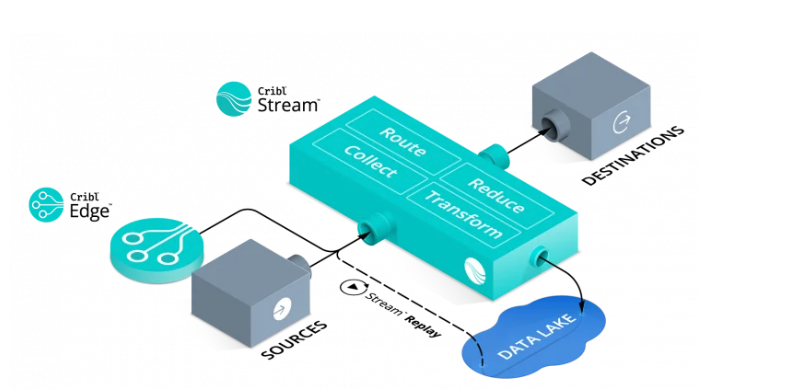Cribl Architecture: Streamlining Data Processing Excellence

In today’s data-driven world, efficient and flexible data processing is the key to success. Enter Cribl Architecture, a cutting-edge solution that redefines the way organizations handle their data. In this article, we’ll delve into the intricacies of Cribl Architecture, exploring its components, scalability, use cases, integration capabilities, security, monitoring, and what the future holds for this transformative technology.
Cribl LogStream: Unveiling the Powerhouse
At the heart of Cribl Architecture lies LogStream, a versatile tool that revolutionizes data processing. LogStream boasts a multi-faceted functionality, including data ingestion, transformation pipelines, and routing capabilities.
- Data Ingestion: LogStream seamlessly ingests data from various sources, ensuring a unified data stream for further processing.
- Transformation Pipelines: With LogStream, you can build customized transformation pipelines that modify data on the fly, enabling real-time data enhancement.
- Routing and Filtering: LogStream intelligently routes and filters data, directing it to the appropriate destination, whether it’s a storage system, analytics platform, or another tool in your data stack.
Cribl LogStream Functions: Crafting Data Brilliance
LogStream offers a range of powerful functions to enhance your data processing capabilities:
- Parsing: LogStream parses complex data formats, ensuring structured data for analysis.
- Anonymization: Protect sensitive information with data anonymization functions.
- Enrichment: Enrich your data with context, adding value for downstream processes.
- Compression: Optimize storage and transmission with data compression functions.
Scalability and Performance
Cribl’s Scalability Magic
Cribl Architecture embraces scalability, allowing organizations to handle growing data volumes effortlessly.
- Horizontal Scaling: Add more LogStream instances to distribute the workload horizontally and accommodate increasing data loads.
- Load Balancing: Load balancing ensures even distribution of data processing tasks, preventing bottlenecks.
- Data Resilience: Cribl ensures data resilience, guaranteeing data availability even in the face of system failures.
- Real-time Processing: Real-time processing capabilities enable quick insights and rapid response to emerging data trends.
Where Cribl Architecture Shines
Cribl Architecture finds its place in various domains, including:
- Log Management: Simplify log management and analysis, making troubleshooting a breeze.
- Security Information and Event Management (SIEM): Enhance your SIEM systems with real-time data processing and threat detection.
- Data Lakes: Seamlessly integrate Cribl into your data lake architecture for streamlined data ingestion and transformation.
- Cloud Migration: Simplify data migration to the cloud while maintaining data quality and integrity.
Integration Capabilities
Connecting the Dots
Cribl Architecture offers extensive integration capabilities:
- Third-party Integrations: Easily integrate Cribl with your existing tools and platforms.
- Custom Connectors: Create custom connectors to interact with specialized data sources.
- Data Destination Options: Flexibly route data to various destinations, whether on-premises or in the cloud.
Security and Compliance
Data Security at its Core
Cribl prioritizes data security and compliance:
- Data Encryption: Secure data in transit and at rest with robust encryption mechanisms.
- Access Control: Implement fine-grained access control to restrict data access to authorized personnel.
- Compliance Reporting: Simplify compliance reporting with built-in features for auditing and reporting.
Monitoring and Optimization
Keeping an Eye on Performance
- Dashboards and Alerts: Monitor LogStream performance with intuitive dashboards and set up alerts for anomalies.
- Performance Tuning: Optimize LogStream configurations for peak performance.
- Resource Management: Efficiently manage resources to ensure cost-effective data processing.
Future Trends and Developments
What Lies Ahead
As technology evolves, Cribl Architecture continues to push the envelope:
- Machine Learning Integration: Expect deeper integration with machine learning for smarter data processing.
- Automation Features: Look out for enhanced automation capabilities to simplify complex data workflows.
- Cloud-Native Adoption: Cribl is set to embrace cloud-native architectures, offering more flexibility for cloud-based deployments.
In conclusion, Cribl Architecture represents a paradigm shift in data processing, empowering organizations to extract maximum value from their data while ensuring security, scalability, and future readiness. Embrace Cribl Architecture to embark on a data processing journey that redefines what’s possible in the digital era.
Join Cloud Shield Tech in the GovTech revolution, and let’s work together to build a better future for government agencies.